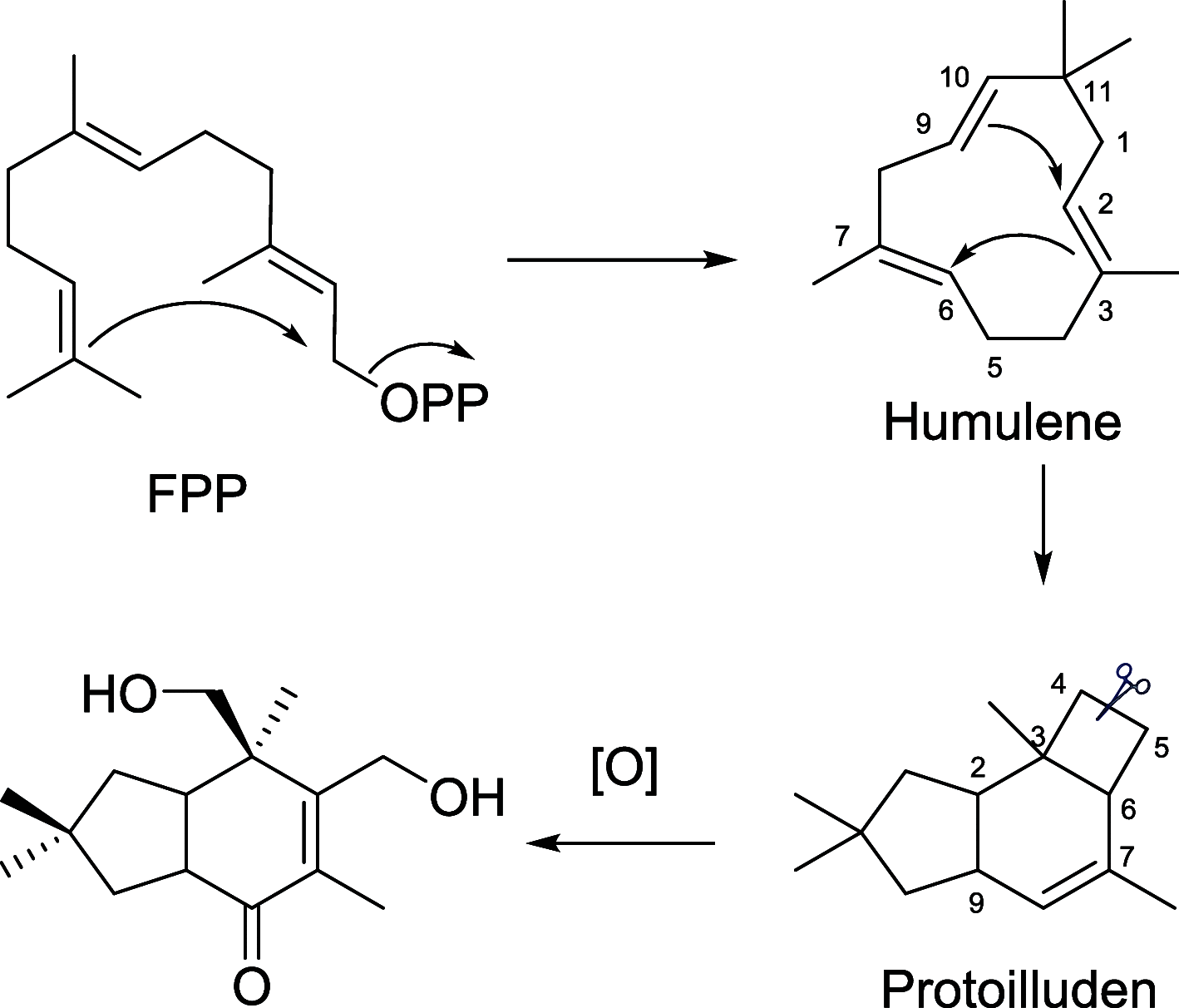Illudane Sesquiterpenoids from Edible Mushroom Agrocybe salicacola and Their Bioactivities
- PMID: 32905428
- PMCID: PMC7469647
- DOI: 10.1021/acsomega.0c03314
Illudane Sesquiterpenoids from Edible Mushroom Agrocybe salicacola and Their Bioactivities
Abstract
To comprehensively understand the chemical constituents of the edible mushroom Agrocybe salicacola and their biological functions, a phytochemical separation of the cultural broth of A. salicacola led to the isolation of four new illudane sesquiterpenoids, agrocybins H-K (1-4), along with 10 known analogues (5-14). Compounds 2-4 were racemates of which 2 and 3 were further separated into single enantiomers as 2a/2b and 3a/3b. All new structures with absolute configurations were elucidated on the basis of an extensive spectroscopic analysis and quantum chemistry calculations. Compound 1 possesses a new carbon skeleton that might be derived from the protoilludane backbone. Compounds 1, 5, 8, and 9 show a certain degree of cytotoxicity to five human cancer cell lines. Compound 1 shows a mild inhibitory effect on nitric oxide production with an IC50 value of 31.4 μM. It is concluded that A. salicacola is rich in illudin derivatives with potential bioactivity prospects, which would make A. salicacola a good material of medicine and food homology.
Copyright © 2020 American Chemical Society.
Conflict of interest statement
The authors declare no competing financial interest.
Figures
Similar articles
-
Two new sesquiterpenoids from basidiomycete Agrocybe salicacola.J Asian Nat Prod Res. 2010 Jun;12(6):464-9. doi: 10.1080/10286020.2010.489822. J Asian Nat Prod Res. 2010. PMID: 20552485
-
Illudin T, a new sesquiterpenoid from basidiomycete Agrocybe salicacola.J Asian Nat Prod Res. 2011 May;13(5):430-3. doi: 10.1080/10286020.2011.566218. J Asian Nat Prod Res. 2011. PMID: 21534041
-
Immunosuppressive Sesquiterpenoids from the Edible Mushroom Craterellus odoratus.J Fungi (Basel). 2021 Dec 8;7(12):1052. doi: 10.3390/jof7121052. J Fungi (Basel). 2021. PMID: 34947034 Free PMC article.
-
Isolation, Identification, and Bioactivity of Monoterpenoids and Sesquiterpenoids from the Mycelia of Edible Mushroom Pleurotus cornucopiae.J Agric Food Chem. 2013 May 29;61(21):5122-9. doi: 10.1021/jf401612t. Epub 2013 May 16. J Agric Food Chem. 2013. PMID: 23650961
-
Characterization of Non-coding Regions in B Mating Loci of Agrocybe salicacola Groups: Target Sites for B Mating Type Identification.Curr Microbiol. 2017 Jun;74(6):772-778. doi: 10.1007/s00284-017-1247-5. Epub 2017 Apr 10. Curr Microbiol. 2017. PMID: 28393263
Cited by
-
A comprehensive review of secondary metabolites from the genus Agrocybe: Biological activities and pharmacological implications.Mycology. 2023 Dec 25;15(2):162-179. doi: 10.1080/21501203.2023.2292994. eCollection 2024. Mycology. 2023. PMID: 38813473 Free PMC article. Review.
-
Sesquiterpenoids Specially Produced by Fungi: Structures, Biological Activities, Chemical and Biosynthesis (2015-2020).J Fungi (Basel). 2021 Nov 30;7(12):1026. doi: 10.3390/jof7121026. J Fungi (Basel). 2021. PMID: 34947008 Free PMC article. Review.
-
Telomere-to-Telomere Haplotype-Resolved Genomes of Agrocybe chaxingu Reveals Unique Genetic Features and Developmental Insights.J Fungi (Basel). 2024 Aug 25;10(9):602. doi: 10.3390/jof10090602. J Fungi (Basel). 2024. PMID: 39330362 Free PMC article.
References
-
- Kirk P. M.; Cannon P. F.; Minter D. W.; Stalpers J. A.. Dictionary of the Fungi, 10th ed.; CAB International: Wallingford, 2008.
-
- Yang Z. L.; Mu Z.; Liu X. X. Agrocybe salicacola, a new species of Sect. Aporus from Yunnan. Acta Bot. Yunnanica 1993, 15, 18–20.
-
- Zhu Y. C.; Wang G.; Yang X. L.; Luo D. Q.; Zhu Q. C.; Peng T.; Liu J. K. Agrocybone, a novel bis-sesquiterpene with a spirodienone structure from basidiomycete Agrocybe salicacola. Tetrahedron Lett. 2010, 51, 3443–3445. 10.1016/j.tetlet.2010.04.128. - DOI
-
- Liu L. Y.; Zhang L.; Feng T.; Li Z. H.; Dong Z. J.; Li X. Y.; Su J.; Li Y.; Liu J. K. Unusual illudin-type sesquiterpenoids from cultures of Agrocybe salicacola. Nat. Prod. Bioprospect. 2011, 1, 87–92. 10.1007/s13659-011-0018-4. - DOI
LinkOut - more resources
Full Text Sources







